|
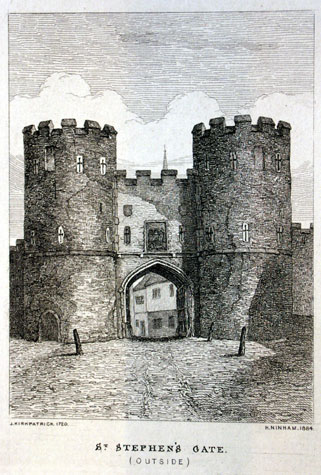
[2]View of the outside of St Stephen's Gate about 1720 engraved by
Henry Ninham from a drawing by John Kirkpatrick [Norwich
Castle Museum and Art Gallery 1954.138, Todd 5, Norwich, 119a]
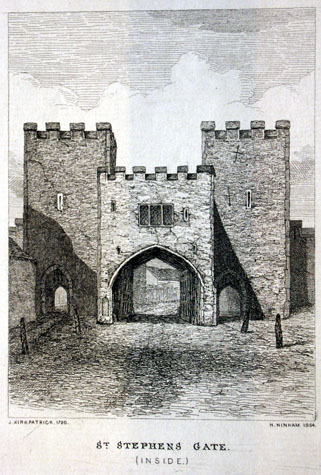
[3]View of the inside of St Stephen's Gate about 1720 engraved by
Henry Ninham from the drawing by John Kirkpatrick [Norwich
Castle Museum and Art Gallery 1954.138, Todd 5, Norwich, 119b]
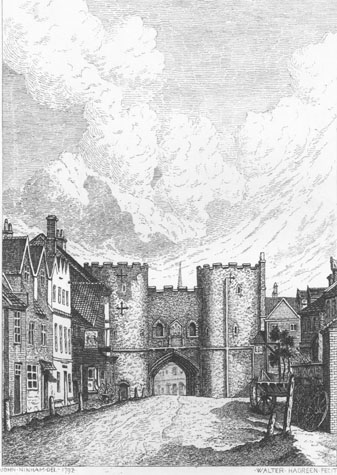
[4]View of the outside of the gateway in 1791 by John Ninham
published by Fitch in 1861.
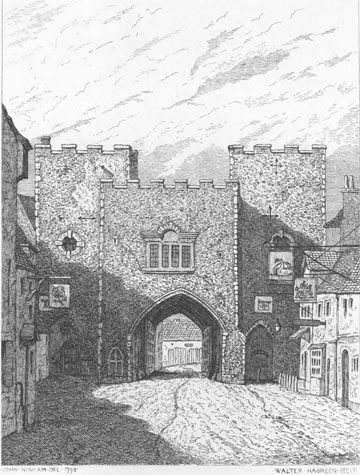
[5]View of the inside of the gateway in 1791 by John Ninham
published by Fitch.
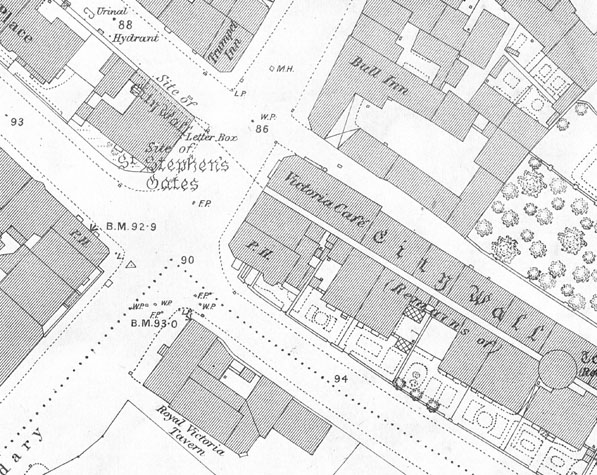
[6]The site of St Stephen's Gate on the 1st Edition of the
Ordnance Survey Map produced in the 1880s.
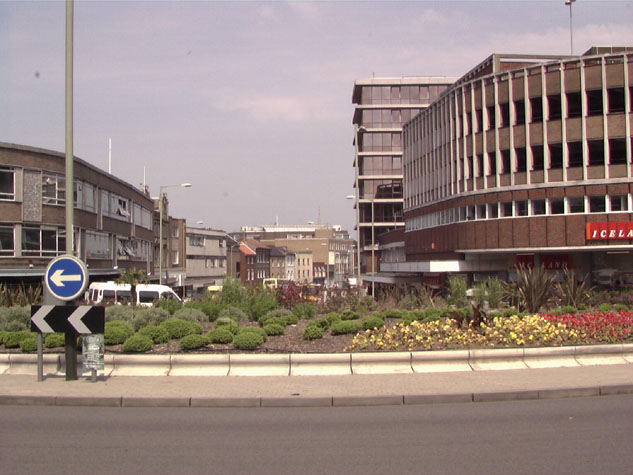
[7]View of the site of the gateway from the west, from outside the
city, looking down St Stephen's.
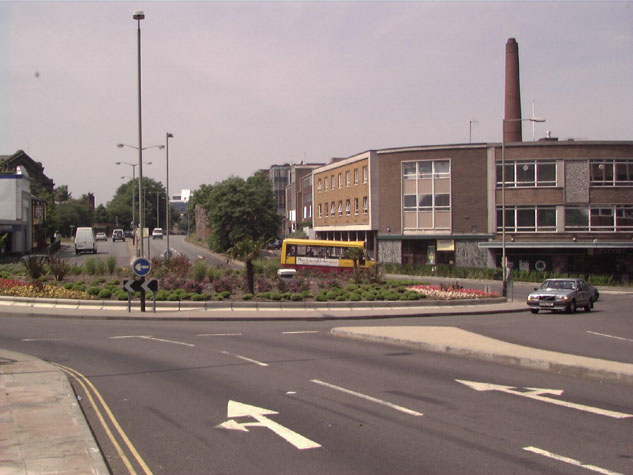
[8]View of the site of the gateway from the east from inside the
city looking along St Stephen's.
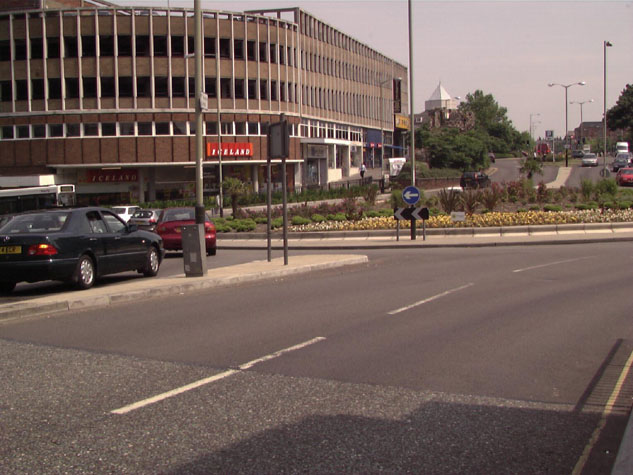
[9]The site of St Stephen's Gate from the
north with the surviving tower and wall beyond.
|
General description
Henry Ninham engravings of 1864 copied John Kirkpatrick's early
18th-century drawings of the inside and outside of the gates.
[NCM Todd Collection, vol. II, box 5, page 119] The drawing from outside
the gate [2]shows two round towers on either side of the gate arch, a
shield above the centre, and the flanking walls are visible to the left
and right. There appears to be some metal bracing on the left tower. The
middle section of the gate looks as if it has been substantially repaired,
and appears to be a different colour to the rest of the gate.
The inside view of the gate [3]shows the towers to be flat on the
east or inner side, and set back from the centre section. Again there is
the suggestion of possible bracing to the top left and lower middle parts
and many fissures are visible in the structure. Walls are shown to the
left and right of the gate, possibly with buildings abutting the gate on
both sides at right angles.
John Ninham's depiction of the outside of the gate in 1792 [NCM
Fitch Collection 1763.76.94]shows a wide single arch with two towers
immediately adjoining the gate to the left and right. [4] The top of the
left hand tower appears to have been repaired with brick, and has two cross
braces.
The view of the inner side of the gate [NCM Fitch Collection 1764.76.94]
shows the main central part of the gate breaking forward of the two
towers on either side which are square in plan at the back. [5]The angles of
the central part and the flanking towers appear to be strengthened with
stone quoins. The battlements are of brick, and the flint on the left
tower appears somewhat eroded on the right hand side. Public houses abut
the street leading up to the gate on either side, and the flanking walls
are consequently hidden. An open double doorway is shown within the archway
and there is a suggestion that the main way through the gate had a ribbed
vault. The north-east corner of the central part of the gate is strengthened
by a short buttress with an offset level with the springing of the arch.
Immediately to the south of the gate arch is shown a small doorway which
presumably gave access to the staircase up to the chamber over the arch.
The flanking towers both had tall arched doorways towards the street
but both had been reduced in size with smaller doorways within the larger
arch and the door to the north tower looked as if it had been subsequently
blocked. Were both these archways for wickets within the flanking towers?
The towers appear to be at least three storeys and were possibly four
storeys high. In Ninham's view the upper chambers are lit by large
circular windows with prominent key blocks at the cardinal points. The
chamber over the gate arch was lit by a four-light mullion window with a
cornice or hood rising over a blind semicircle over the middle two lights
giving it the appearance of a Venetian or Palladian window. These features
suggest that the gate was remodelled in the middle of the 18th century.
Both of these drawings were reproduced by Fitch in 1861.
Documentary evidence
The earliest surviving document that refers to a gate at St Stephen's
is a lease of 1285 for a house which is identified as south of the gate.
[Quoted in full in Fitch page 11]
Work undertaken on the gates about 1340 and financed, in part, by
Richard Spynk are listed briefly in an account of his work produced in
1343. This work included 'at the two towers two solars of timber, and
board, and two above of timber, board and lead.' [Extract from
The Old Free Book, Hudson & Tingey, Vol. II, page 219]
In 1460 five soldiers were on guard at St. Stephen's gate.
[Blomefield, page163] In 1483 a curious document records that at an
Assembly at Michaelmas it was agreed that Robert Godard, a hermit,
should have his dwelling over the gate and the custody of the ditches
of the city as far as they extend for the aldermanry of St Stephen's
for a yearly rent of 6s 8d and that he should repair the chamber and the
'soller' over it occupied by him. [Fitch page 12]
In the 16th century two documents reflect the widely different ceremonial
functions of the gates. In 1561 a gibbet was erected on the outside of the
gates. [Blomefield, page 279]In 1578 the gates were improved and repaired
for a visit by the queen, as follows:
The gate itself was thus inriched and beautified; first the portcullis
was new made both timber and iron: the outward side of the gate was thus
beautified; the Queen's arms were most richly and beautifully set forth
in the chief front of the gate; [as were St. George's cross and the
arms of the city]... The inner side of the gate was thus beautified; on the
right side was gorgeously set forth the red rose, representing the house
of Lancaster, in the midst was the white and red rose united,
expressing the union; under which was placed by descent the arms of the
Queen [with verses written below]...[Blomefield, page323]
In 1733 the front of St. Stephen's Gate were 'beautified'
[Blomefield, page 448] Presumably this was when the fenestration on the
east or inner side of the gate was altered.
The Tonnage Books contain several entries relating to the repair of
the gates during the 18th century. In 1754 the road and pavement near and
through the gate was to be cleaned and maintained, and in 1757 it was
ordered that the gate be 'coloured over'. In 1761 it was ordered
that the defective lead roof of the gate be removed and replaced with tiles.
[N.R.O. NCR Case 19 Shelf C; Fitch page 14]
In 1792 an advertisement was placed in the Norfolk Chronicle
for proposals to remove the gate, and in 1793 they were taken down.
The editor of the paper commented on this. 'On Monday last the
ruthless hands of men began to execute the sentence of demolition passed
upon the venerable Gates of this City: Brazen Doors have met their fate,
St Stephen's follows next.'
In 1842 Blyth's Directory describes St. Stephen's Gate in
some detail, as:
The principal of the city gates, and was a large building,
consisting of a pointed arch, over which was a chamber, formerly
used as a hermitage or chapel. On the sides were two lofty towers,
square on the city side, and round on the outside. The western tower
had a postern, used as a footway ... The whole was embattled and enlightened
with embrasures.' [Blyth, page 4]
Map evidence:
Cunningham's view of the city in 1558 shows the bridge before
St Stephen's gate with two arches. Both Kirkpatrick's map
[Norwich Castle Museum 1894.76.1682:F]and Cleer's map of 1696
show that right up to the end of the 17th century there were virtually
no buildings outside the gate. Thomas Cleer shows just two houses on
each side of the London Road immediately outside the ditch.
The map of 1789 by Hochstetter shows that by then the ditch in front
of the wall on the south side of the gate had been filled in but the
ditch to the north of the gate had been enclosed with a low fence and
there was a long narrow pond here. This was for watering horses and
for watering cattle being driven in to the market in the city.
The first edition of the Ordnance Survey map in 1884 [Sheet LXIII.15.7]
shows the wall immediately to the south of the gate still standing but
with buildings against it on both sides. [6] On the north side of the
gate the wall appears to survive beyond the building on the corner and
continued behind the terraced row called Chatham Place that had been built
over the ditch and faced outwards on to Chapel Field Road.
Present state: archaeology, conservation and potential excavations
The site of the gate is now completely occupied by a large roundabout
at the junction of St Stephens, Chapel Field Road, the London road and
Queen's Road. [7, 8 & 9] This was constructed in 1964 and the
deep underpasses here must have destroyed all the archaeological remains
of the gate. [25-01 Map] A report records that the foundations of St.
Stephen's Gate were revealed while excavating for the subway.[SMR NF261]
BIBLIOGRAPHY:
Blomefield, Francis, An Essay Towards the Topographical History of the
County of Norfolk, vol. III: The History and County of Norwich Part I
(London: W. Bulmer, 1806)
Blyth, G.K., The Norwich Guide and Directory (London: R. Hastings;
Norwich: Josiah Fletcher, 1842)
Fitch, Robert, Views of the Gates of Norwich made in the years 1792-3 by
the Late John Ninham (Norwich: Cundall, Miller, and Leavins, 1861)
Hudson, William, and Tingey, John C., The Records of the City of Norwich,
2 vols. (Norwich & London: Jarrold & Sons, 1906 & 1910)
Norfolk Chronicle, October 27th, 1792
See also:
Collins, Arthur E., The Walls of Norwich (City and County of Norwich,
Norwich: Jarrold & Sons, 1910)
Pococke, Edward, 'Sixteen Drawings of the Gates of Norwich', NCM
1955.219:IN
Winter, C.J.W., 'Portion of the City Wall, Disclosed, by Removing Old
Houses, St. Stephen's, Norwich', NCM Todd Collection Vol. II, Box 7,
Mancroft, page 37
DOCUMENTARY REFERENCES:
N.R.O. Book of Customs
N.R.O. MF/RO 29/3 f. 177 (Liber Albus)
N.R.O. NCR Case 19 Shelf C (Tonnage Books, 1720-1836)
ARCHAEOLOGICAL REPORTS:
Department of the Environment Report HSD9/2/1005 pt 7, 1988
HISTORIC ILLUSTRATIONS:
Buckler, J., 'St. Stephen's Gate', NCM 1941.12.2:INT
Bright, Henry. 'Ancient Watch Tower on the Old Walls of the City of
Norwich' Norwich Castle Museum, NWHCM:1921.70.10:F
Carter, J., St Stephen's Gate (1786) published in J Britton, On Ancient
Gate-Houses, Proceedings of the Archaeological Institute, July 1847,
opposite page 136
Ninham, Henry, 1864, from John Kirkpatrick, 1720, 'St. Stephen's Gates',
NCM Todd Collection, vol. II, box 5, page 119
Ninham, John, 1792, St. Stephen's Gate, Inside', NCM Fitch Collection
1764.76.94
Ninham, John, 1792, 'St. Stephen's Gate, Outside', NCM Fitch Collection
1763.76.94
|
